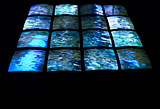|
Preamble
When we look at a TV screen, where is the image located in space? Is it located
behind the TV tube, so that we view it as if looking through a window? Or perhaps,
as science suggests, it only exists as millions of glowing phosphors located
on the surface of the glass tube. Or does the image shine through the tube,
the way that light is emitted from a light bulb? In this installation the reflective
surface of the lake draws attention to some essential qualities of the video
medium, whilst questioning the physical location of the "lake" itself.
Lost Lake represents a metaphysical contemplation on the nature and limits
of the video medium in relation to the natural world.
The Image
The imagery comprises a single, oblique-angle shot of the surface of a small
alpine lake. The water surface fills the frame. A constantly changing pattern
of ripples plays across the water surface, which reflects an inverted image
of trees on the opposite shore. A series of seven three-minute takes, recorded
over a period of several hours, depicts the complex variations in the water
surface as the breeze rises and falls.
The Sound
The sound was digitally recorded and mixed, and comprises the sound of water
trickling over small pebbles and the distant and somewhat ominous sound of
a jet aircraft passing high overhead.
The Wall
The sixteen-monitor video wall measuring 6' x 8' is placed on its back on the
gallery floor to form a video "lake." The image of the lake forms
one large video image, broken only by the grid pattern formed by the monitor
cases. Apart from this, the image is not fragmented spatially (as is customary
on a video wall) but rather the processor will be used to "shuffle" the
seven different takes temporally, giving the impression of an infinite variation
of water surfaces. The wind appears to play the surface of the lake like
a flute.
In the
Gallery
Viewed from one angle, as the viewer enters the gallery, the perspective of
the water surface and the reflected trees makes sense spatially since the viewer's
angle to and distance from the water surface are very similar to that of the
recording camera. As the viewer moves around the "lake," however,
the spatial coherence is disrupted, since the reflection will not move as they
move. The image of the water surface parallels the surface of the monitor screens,
but the water reflects only the image of trees and not the image of the gallery.
A close inspection, staring straight down into the monitors, reveals not the
bottom of the lake or the reflection of the viewer's face, but only an abstract
pattern of light and shade mixing with the electronic components of the video
image.
Footnotes
The image of this lake is inextricably bound up with the technology which brings
it into existence. The graininess of the enlarged video image and the grid
formed by the casings of the sixteen monitors disrupts the spatial continuity
of the picture plane and foregrounds the technology behind the illusion.
As it was being filmed, the surface of the lake reflected the
image of the trees growing around its shores. In the gallery
the surrounding landscape is gone and only its reflection remains.
The lake does not reflect the gallery walls or the people who
come to see it. Through the process of representation the lake
has lost its ability to reflect the world around it. This lake
is very lost indeed!
Chris Welsby – May 1999
Acknowledgements
and Credits
Made with the support of the Canada Council for the Arts, Media Arts
Section, and Performance Video Wall Inc., Vancouver.
Soundsynthesis and mix by Damian Keller.
Please also see the Gallery Programme Notes,
by Petra Watson |
